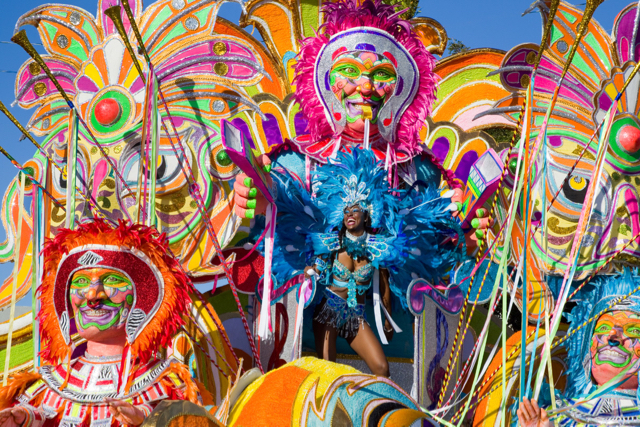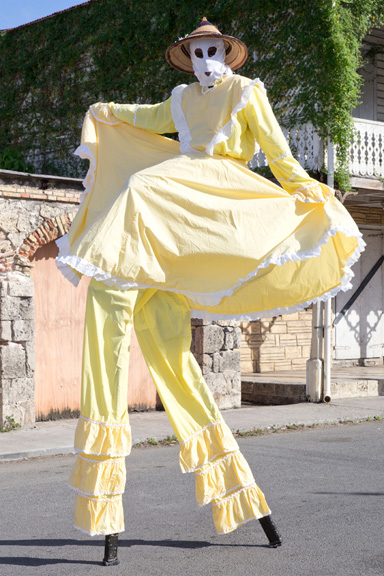
A photography project that began more than 25 years ago, Picayo’s “Caribbean Carnival Portraits” takes viewers on a wide-ranging tour of the Greater and Lesser Antilles’ carnivals, which vary greatly in scale, attire and atmosphere.
Though Picayo has strong ties to the Virgin Islands, the exhibit is something of a homecoming for his work, since he hasn’t exhibited in the territory in 20 years. He still frequented the Virgin Islands during that time, but other ventures including a public access TV show he produced in New York for 13 years and a non-profit he founded, Latino Artists Round Table, took his work elsewhere.
"I consider myself a cultural ambassador of the Virgin Islands, and so much of my work is based on my experiences here. I am glad to bring this exhibit back home. It is definitely about time,” Picayo said.
Picayo was born in Cuba and spent much of his youth in Puerto Rico, but he considers St. Thomas home. When Picayo was 17 years old his father moved the family to St. Thomas for a business opportunity and today Picayo splits his time between St. Thomas and New York City.
After shooting his first carnival in St. Thomas in 1987, Picayo was hooked. What began as an experiment became a passion after he got his first roll of film back.
“I was looking for the photogenic aspects of carnival – I was going for the color. But then I got the slides back and something revealed itself. Beyond the vibrant colors I saw an intensity and a seriousness in people’s faces,” Picayo said.

“Every carnival is a new experience and makes me ask more questions. That curiosity sends me searching for the next festivity,” Picayo said.
The exhibit is a subset of carnival photos from a larger, two-photographer show that was subtitled “The Photography of Mario Picayo and Mariano Hernández.” That exhibit was first shown in Cuba in 2013 and then in the Dominican Republic, Hernández’s home island, and New York in 2014.
Picayo considered only showing photos from the Virgin Islands for the show, but thought that most people here already have some knowledge of local carnival. He hopes the show exposes viewers to a variety of carnival experiences, since there’s at least one photo from each of the 25 islands he’s shot on.
“I limited the exhibit to portraits, since they show the intensity of the fete at a personal level,” Picayo said, adding that photos from the Virgin Islands will show up in large-scale and smaller formats, including in a large collage.
While Picayo thinks every carnival is special, he says some are more distinctive than others. Picayo has found that some carnivals in the Lesser Antilles are becoming more generic as people buy more pre-made, revealing costumes. You won’t see much of this mass-produced attire in his portraits.
Besides the Virgin Islands, Picayo enjoys shooting in Trinidad and the Dominican Republic. As the largest Caribbean festival, Trinidad is in a league of its own, Picayo said, but the Dominican Republic is the place that really captures his imagination even though it doesn’t have the most colorful or beautiful events.
“In terms of originality, I could never exhaust the Dominican Republic – it has such strong African, Spanish and Haitian influences that make for an interesting mix, and each city or town has its own characters,” Picayo said.
What does Picayo find distinctive about carnivals in the Virgin Islands?
For one, Picayo thinks the timing of carnival here is unusual. Most Caribbean celebrations happen before Lent, he observed, but in the territory there is one in January (St. Croix,) after Lent in the spring (St. Thomas) and in July (St. John). That makes for a completely different vibe, he said, since the carnivals have less of a “solemn tone.”
There’s also a number of traditional characters and troupes on all three islands. On St. Thomas, Picayo said, you’ll find the Indians, Zulus and Gypsies, which are some of the island’s oldest and most distinguishable troupes. Picayo added that the Gypsies have been in every single St. Thomas carnival since it began in 1952 and that they notably wear traditional, home-made costumes.
The opening reception for the exhibit takes place from 5:30 to 7 p.m. Friday and will feature local music, food and a book presentation of Picayo and Hernández’s work.
Sponsors for the exhibit include the Virgin Islands Council on the Arts (VICA), V.I. Department of Tourism, LART, Barefoot Wines and its distributor West Indies Company, Carnival Kaleidoscope and ColorMax.





